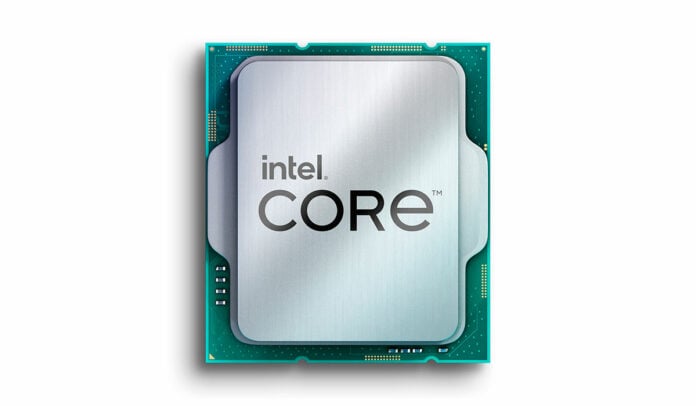Intel is forging ahead with the release of 13th Gen Core processors for the mainstream desktop CPU market. Officially announced today at an Innovation event being held in San Jose and available on-shelf October 20, let’s examine the considerable firepower Intel is bringing in response to AMD 7000 Series CPUs released just yesterday.
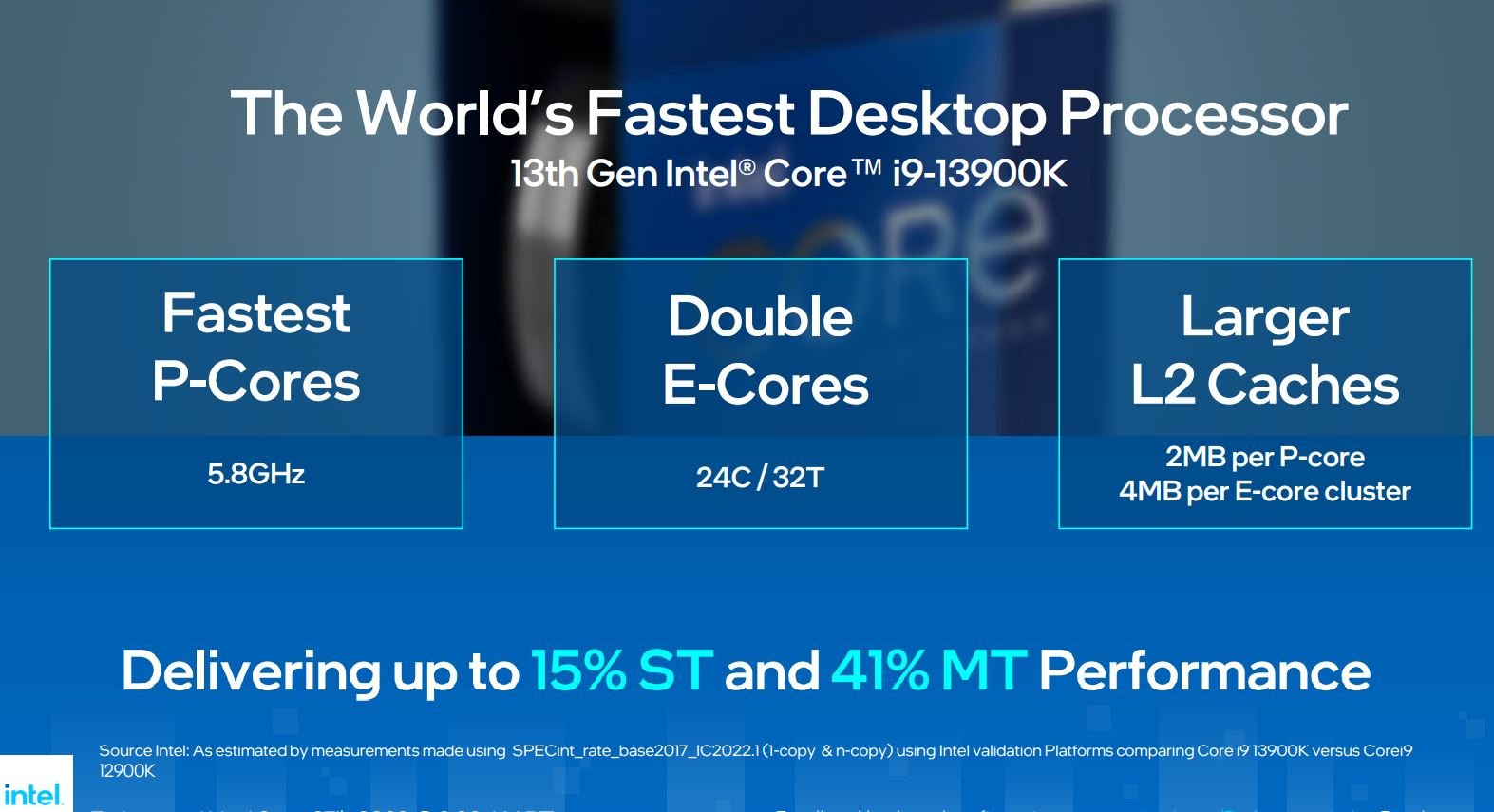
Intel makes no bones about the performance reach of 13th Gen Core, codenamed Raptor Lake. Though rumours have been running wild, this is the first time the Core team divulges true specifications. Key callouts are faster P-cores, double the number of E-cores for each family, and larger caches.
Fitting into the same LGA1700 socket as incumbent 12th Gen Core Alder Lake processors released at the tail end of last year, 13th Gen Core is a refinement rather than grounds-up design. That’s totally normal and expected for this next iteration.
Intel says adding both speed and cores boosts Core i9-13900K performance in single-threaded applications by up to 15 per cent over an already-fast Core i9-12900K, while multi-thread gains measure a very creditable 41 per cent.
What’s New
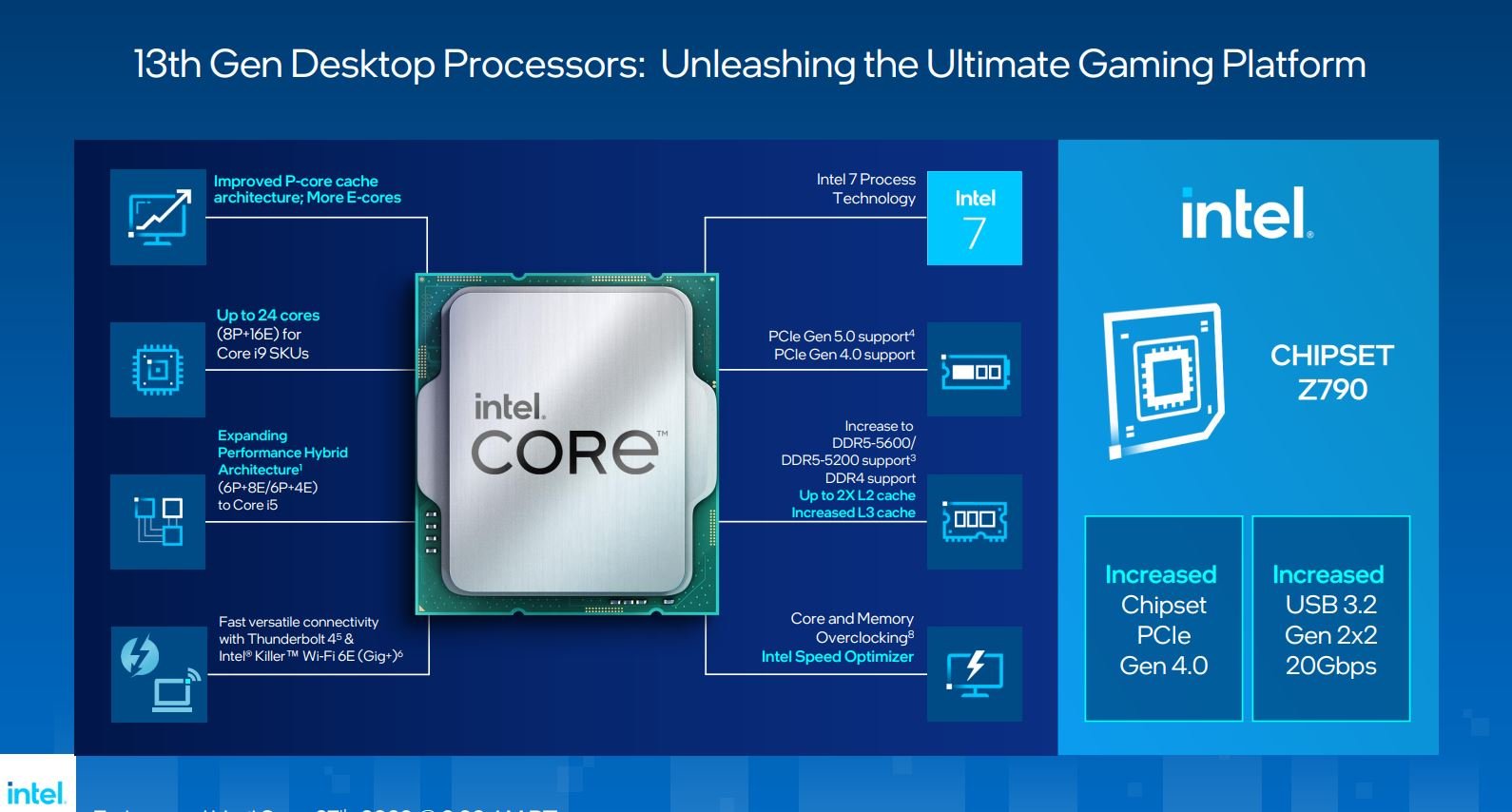
This purported gain is achieved without moving from the ‘Intel 7’ 10nm Enhanced SuperFin process used on Alder Lake. An impressive feat considering more cores and cache are being driven to higher frequencies.
Extrapolating from the above slide, Intel is adding more E-cores for Core i5, Core i7 and Core i9 families. This means there’s greater processing power across the entire divulged stack. On top of that, the hybrid memory controller is now specified for native operation at DDR5-5600 speeds, up from 4800MT/s on 12th Gen Core.
Intel is further announcing 700 Series chipsets to fully support 13th Gen Core processors. Flagship Z790, however, doesn’t differ much from today’s Z690, which will also support Raptor Lake processors through a BIOS update.
Moving with the times, chipset PCIe 3.0 lanes are reduced from 16 to 8, while 4.0 lanes conversely rise from 12 to 20, primarily to service high-speed expandability for peripherals hanging off the PCH. There’s a further USB 3.2 2×2 20Gbps port, as well, but that’s your lot.
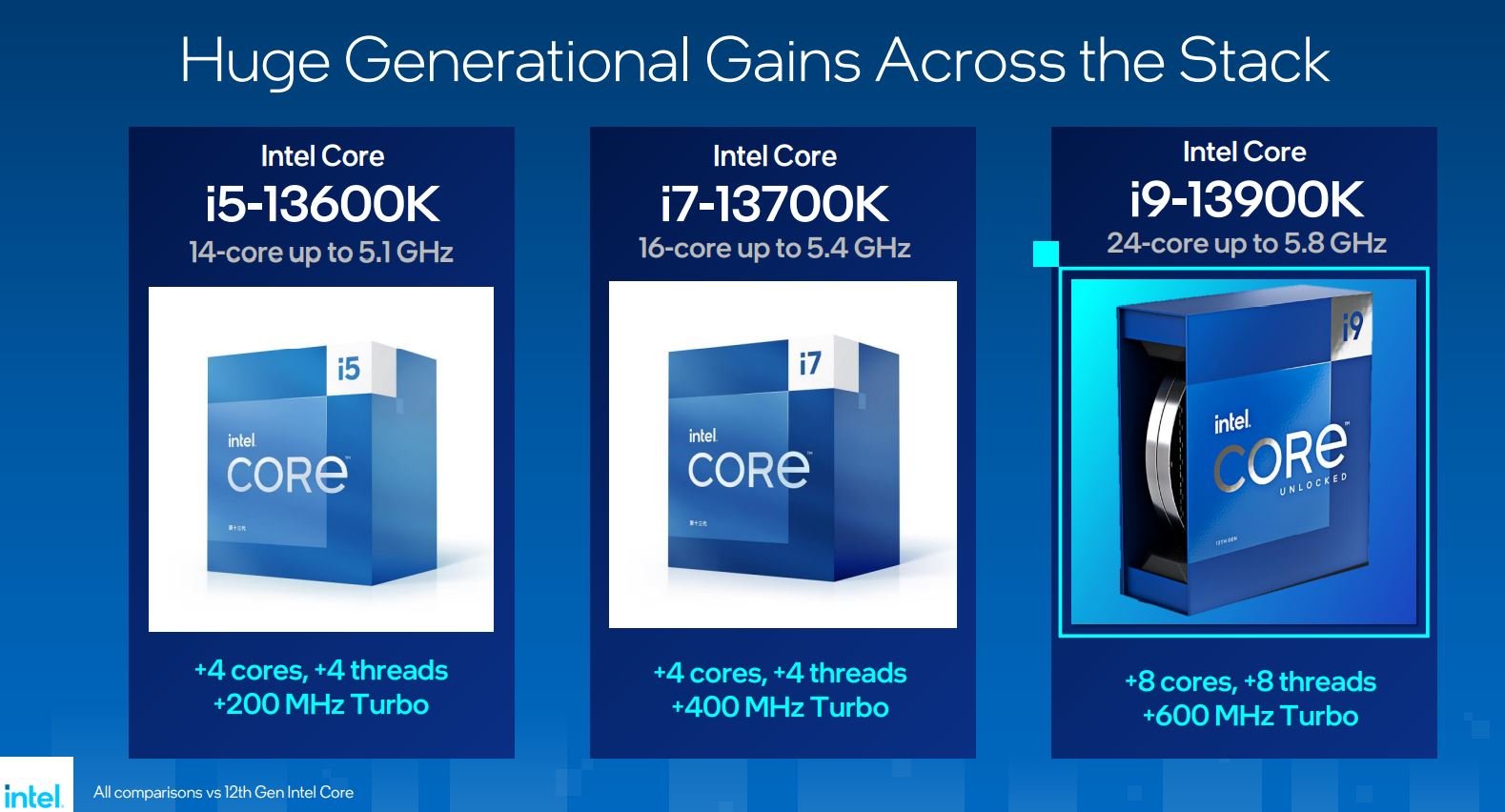
Fuelling Performance Through More Cache
Intel comments it’s been able to boost Raptor Lake frequencies by using an improved version of third-generation Intel 7 process. Like the latest Ryzens, this translates to shifting the voltage/frequency curve out by a reasonable amount.
13th Gen Core can run at the same speed as 12th Gen Core with 50mV less juice – leading to the appetising idea of heaps of performance at reduced TDPs – or offer an additional 200MHz at the same voltage. Cranking out more speed with an expanded TDP range is how 13th Gen Core i9 scales up to 600MHz higher.
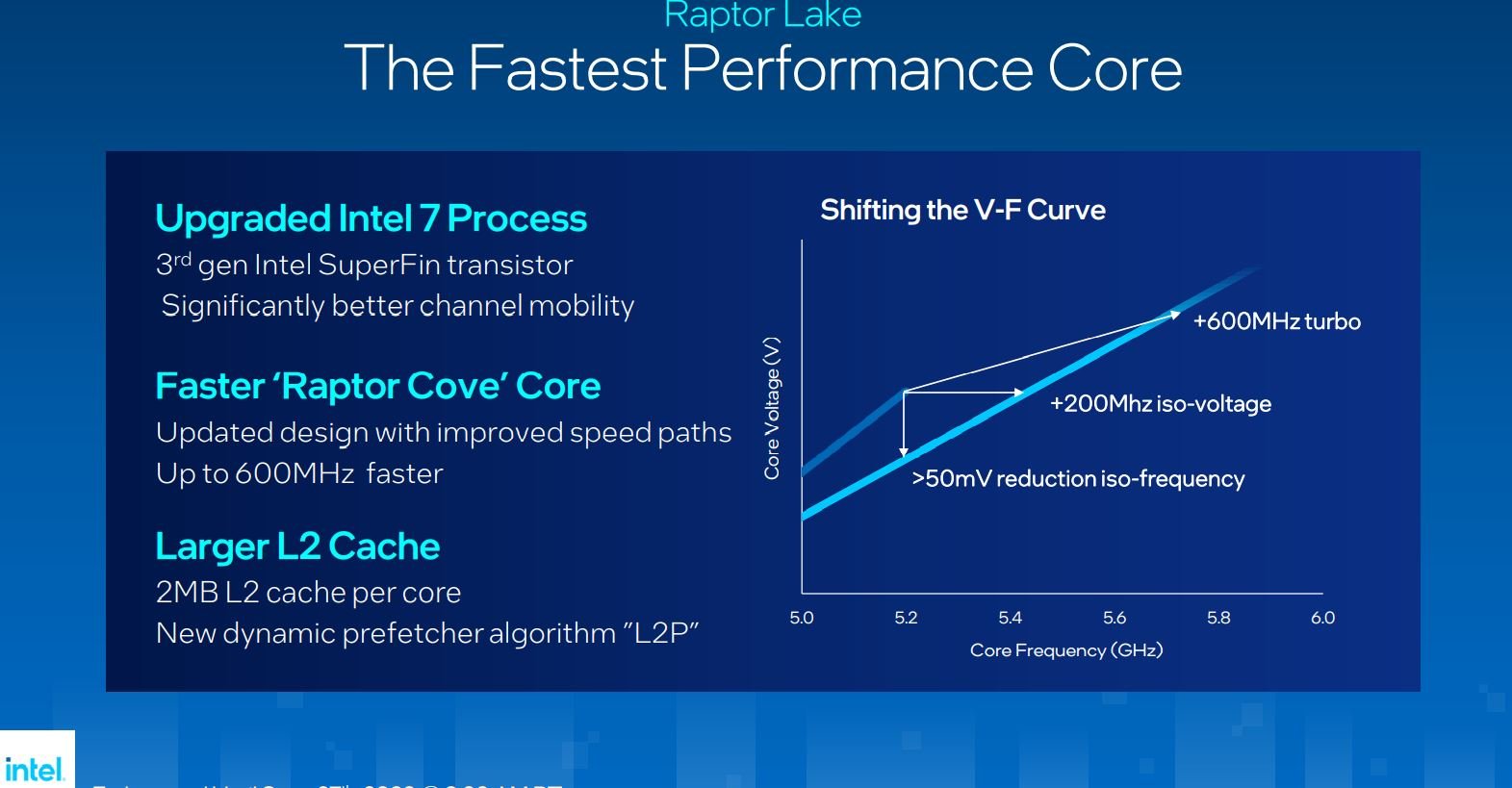
We know E-cores are more numerous this generation and Intel keeps to the tried-and-trusted Gracemont microarchitecture – the smaller cores are identical on Alder and Raptor Lake. That said, performance ought to be better as Intel doubles L2 cache from 2MB per four-core E-core cluster to 4MB. A small but important detail.
P-cores also benefit from more L2 cache. You may recall 12th Gen offered 1.25MB per core – 13th Gen ups this to 2MB. Put simply, an 8P+8E chip (16 cores, 24 threads) from the Alder Lake generation carries a total 14MB L2 (8×1.25 + 2×2) while Raptor Lake jumps to 24MB (8×2 + 2×4). More cache never hurts if latency is kept at around the same levels, and Intel also adds to L3 capacity for each family. Getting the feeling Intel is going gung-ho with nary a thought for ballooning transistor budgets?
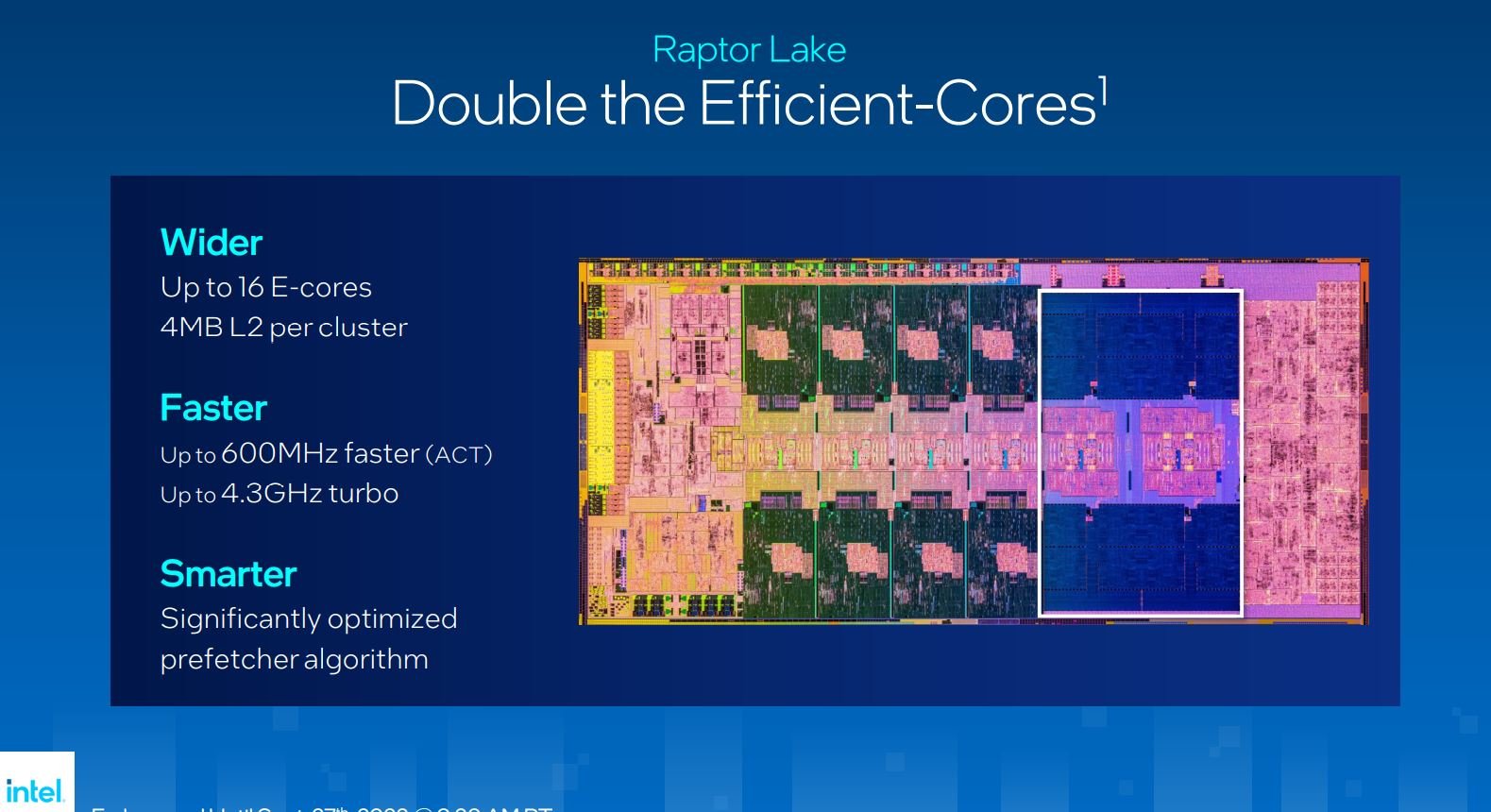
Raptor Cove Operates Differently To Golden Cove
A new addition is what Intel terms a significantly optimised prefetcher algorithm. Speaking to Adi Yoaz, chief architect for P-cores, this is actually a feature baked into Alder Lake too. There’s a firmware-upgradeable power management microcontroller built into Alder Lake’s Golden Cove P-cores which runs on a per-core basis and offers fine-grained adjustments.
For Raptor Cove P-cores Intel is extending the reach of this microcontroller to adjust other aspects of the core aside from monitoring telemetry and adjusting frequencies. Yoaz told Club386 Intel can control the behaviour of the prefetching unit and whether the L2 and L3 caches are inclusive or non-inclusive by introducing new algorithms through firmware updates. Knowing the microcontroller affects parameters every 200 microseconds, there’s plenty of on-the-fly optimisation taking place on Raptor Cove. What’s more, constant machine learnings update algorithms so that application performance improves over time.
In the future, using this microcontroller, “Intel will have more and more algorithms that will adapt and modify the machine to the actual application that’s being run,” continued Yoaz.
Given this is a firmware-led upgrade and the microcontroller technology already exists in Alder Lake, an interesting question is whether it can be backported to 12th Gen Core for improved performance. Intel chose not to answer this pressing question during my chat with Adi at a technical tour event in Israel a few weeks back. I believe the enhanced prefetching and cache algorithms in Raptor Cove are marketing decisions first and foremost, to help differentiate from the direct predecessor which effectively uses the same core technology. Liberally applied in the server business, Intel is no stranger to expanded performance via firmware updates.
Models And Comparisons
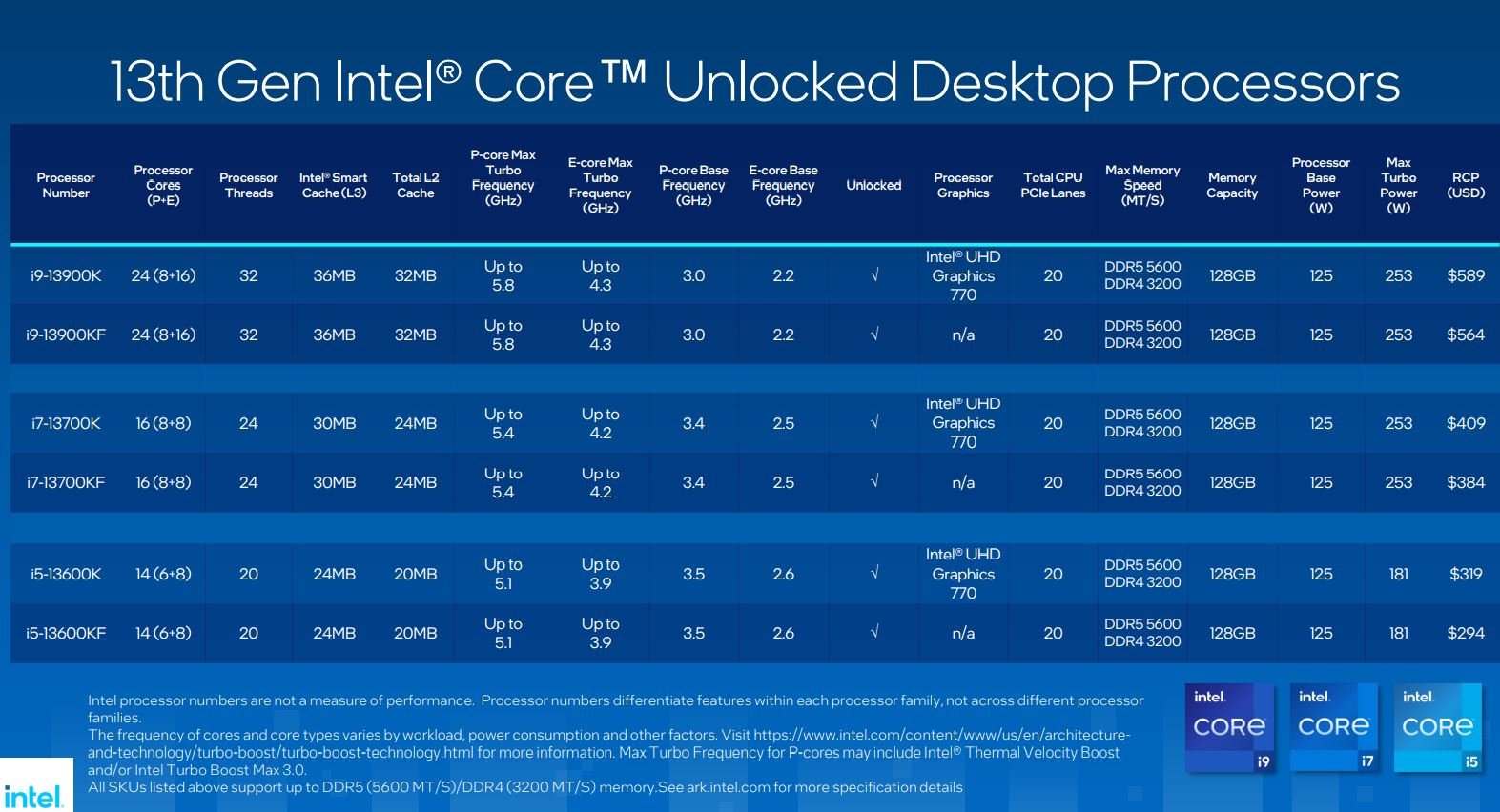
The notion of more, more, more translates into this six-CPU tranche. Notice how Core i5 jumps to 44MB of combined L2 and L3 cache, Core i7 to 54MB and Core i9 to a whopping 68MB. That’s a fair bit more than 12th Gen Core, as we’ll explain in the table below.
Devil is in the details as Intel hasn’t announced any non-K(F) chips. Rumours are abounding that processors below the Core i5-13600K(F) will use Alder Lake technology rather than Raptor Lake, with core-and-thread counts and frequency massaged to fit into the intended Core i5 and Core i3 segments. Time will tell.
| CPU | Cores | Threads | L2 | L3 | Turbo | Base TDP | Max TDP | MSRP |
|---|---|---|---|---|---|---|---|---|
| Core i9-13900K | 24 (8P+16E) | 32 | 32MB | 36MB | 5.8GHz | 125W | 253W | $589 |
| Core i9-12900K | 16 (8P+8E) | 24 | 14MB | 30MB | 5.2GHz | 125W | 241W | $589 |
| Core i7-13700K | 16 (8P+8E) | 24 | 24MB | 30MB | 5.4GHz | 125W | 253W | $409 |
| Core i7-12700K | 12 (8P+4E) | 24 | 12MB | 25MB | 4.9GHz | 125W | 190W | $409 |
| Core i5-13600K | 14 (6P+8E) | 20 | 20MB | 24MB | 5.1GHz | 125W | 181W | $319 |
| Core i5-12600K | 10 (6P+4E) | 16 | 9.5MB | 20MB | 4.9GHz | 125W | 150W | $289 |
Presented here are some of the best chips from the 12th and 13th Gen families. Core i9 adds a further eight E-cores and, as explained earlier, increases cache sizes markedly. Not only that, but frequency also sees a healthy uptick, so it’s inevitable Core i9-13900K will be faster than Core i9-12900K in every meaningful scenario. Catering for higher clocks, Intel ups maximum power to 253W.
13th Gen Core i7 looks a lot like 12th Gen Core i9. It’ll probably end up being faster by dint of better caching and higher frequencies, while the newest Core i5 looks set to match today’s Core i7. In effect, then, Intel is going up a class of processor for this new generation.
Murmurings of heightened pricing are unfounded. Top-bin chips for Core i9 and Core i7 arrive at the same $589 and $409 pricing as their immediate predecessors and it is only Core i5 that sees a 10 per cent increase: Intel is offering more performance for around the same money. It is reasonable to expect premium 12th Gen Core chips will have a price cut on October 20, to keep them attractive for those who can’t justify 13th Gen money.
It’s clear Intel has prioritised all-out performance at the expense of power and, arguably, profit. It cannot be cheap to up the thread count, caches and frequency, on the same manufacturing node, whilst keeping pricing mostly the same as the last generation, which, let’s not forget, is hardly bad to begin with.
Probable Performance
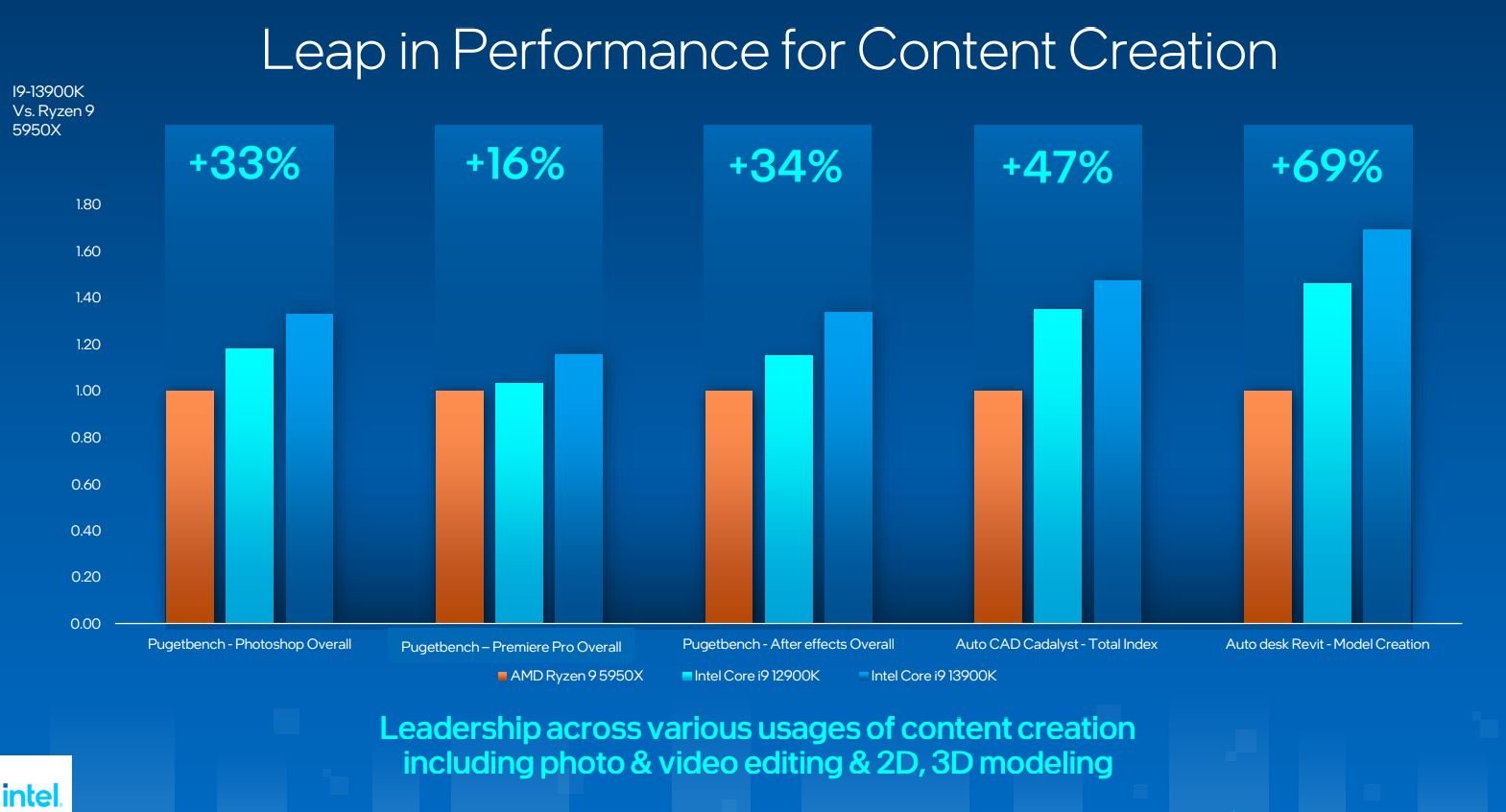
A key question is where do these new Core processors sit in the wider mainstream PC landscape? Intel hasn’t been able to answer that question because, understandably, it only had access to rival AMD’s Ryzen 5000 Series processors at the time of testing. Perhaps Club386 can lend a hand.
Citing multi-core gains of between 16 and 69 per cent for Core i9-13900K vs. Ryzen 9 5950X, we can extrapolate that the new head honcho ought to benchmark in the same ballpark as Ryzen 9 7950X. Let the high-stakes battle commence!
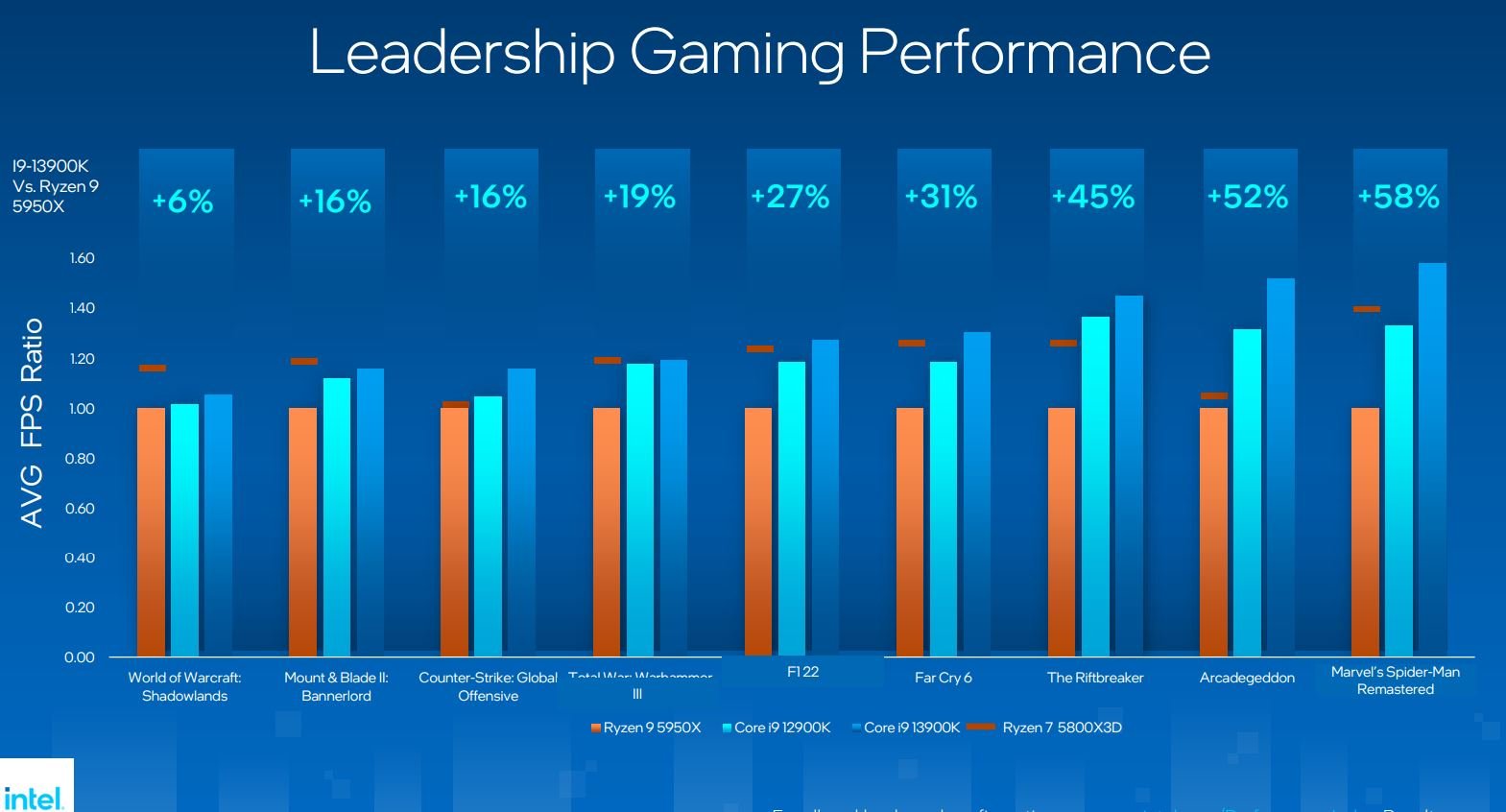
Choosing games that run best on the Core architecture, Intel’s slides reveal performance that it defines as ‘leadership.’ Generally punching above cache-enriched AMD Ryzen 7 5800X3D on these results, the proof will be once we have Core i9-13900K in our labs.
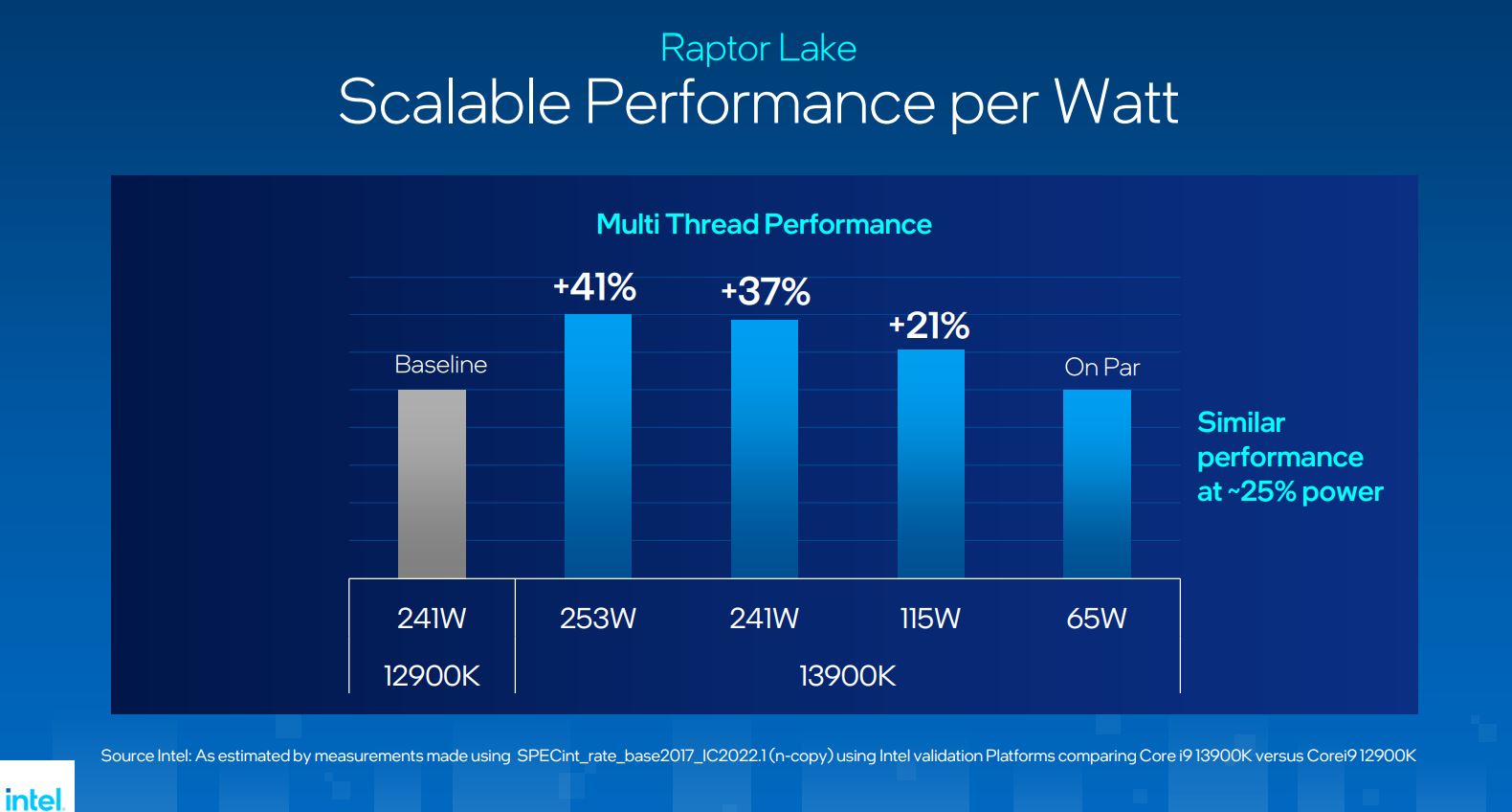
Let’s leave you with a final slide Intel is rather fond of, detailing how a Core i9-13900K is able to deliver the same performance as a 241W Core i9-12900K at only 65W. Are you not entertained?

